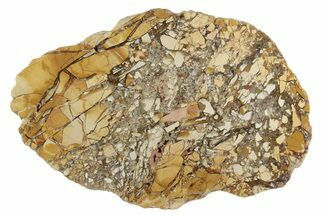This Specimen has been sold.
7.45" Polished Petrified Wood (Aruacaria) Slab - Australia
This is a 7.45" wide slab of petrified wood from Australia. The wood itself is from Aruacaria, a type of conifer, and is Cretaceous in age. It comes from the same petrified wood deposit that produces "peanut wood", though it appears to be from a part of the tree that wasn't very aggressively bored by the clam larvae. Some of these boreholes can be found along one edge. There is a repaired crack through this slab, hence the slightly reduced price.
Peanut wood gets its name due to the fact that it is petrified driftwood that contains boreholes from clam larvae of the genus Teredo, commonly know as shipworms. These boreholes become filled in by a white mineral during the fossilization process, giving the petrified wood it's unique appearance.
It comes with an acrylic display stand.
Peanut wood gets its name due to the fact that it is petrified driftwood that contains boreholes from clam larvae of the genus Teredo, commonly know as shipworms. These boreholes become filled in by a white mineral during the fossilization process, giving the petrified wood it's unique appearance.
It comes with an acrylic display stand.
What Is Petrified Wood
Petrified wood is the name given to wood that has been turned into stone (fossilized) through the process of permineralization. In this process, all of the organic matter becomes replaced by minerals, while much of the original structure, such as tree rings, is retained. For this to happen, the wood needs to be buried in an environment low in oxygen to prevent decomposition and with flowing, mineral-laden water, so minerals may replace structures. The coloration is caused by various minerals that present in that water during fossilization. For example, red colors are due to iron compounds, greens due to copper, and so on.
Petrified wood is the name given to wood that has been turned into stone (fossilized) through the process of permineralization. In this process, all of the organic matter becomes replaced by minerals, while much of the original structure, such as tree rings, is retained. For this to happen, the wood needs to be buried in an environment low in oxygen to prevent decomposition and with flowing, mineral-laden water, so minerals may replace structures. The coloration is caused by various minerals that present in that water during fossilization. For example, red colors are due to iron compounds, greens due to copper, and so on.
SPECIES
Aruacaria sp.
LOCATION
Gascoyne, Western Australia
SIZE
7.45 x 3.8", .35" thick
CATEGORY
SUB CATEGORY
ITEM
#225051
We guarantee the authenticity of all of our specimens.
 Reviews
Reviews











